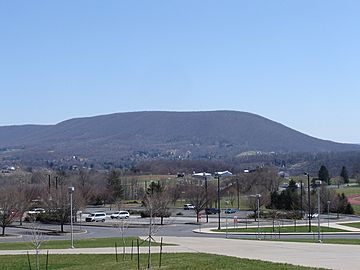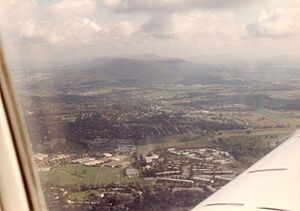Mount Nittany facts for kids
Quick facts for kids Mount Nittany |
|
|---|---|

Southern terminus of Mount Nittany ridge, looking east from the Bryce Jordan Center near State College
|
|
| Highest point | |
| Elevation | 2,077 ft (633 m) |
| Geography | |
| Location | Centre County, Pennsylvania, U.S. |
| Parent range | Appalachian Mountains |
| Topo map | USGS State College Quadrangle |
| Climbing | |
| Easiest route | White Trail |
Mount Nittany is a well-known mountain in Centre County, Pennsylvania, USA. It's also called Nittany Mountain. This mountain is part of a long ridge. This ridge separates two valleys: Nittany Valley and Penns Valley. There's also a smaller valley called Sugar Valley between parts of the ridge.
On maps, Mount Nittany is usually shown as a lower ridge. It runs below Big Mountain and Big Kettle Mountain. These ridges come together at the mountain's southern end. Sometimes, the name "Nittany Mountain" is used for other parts of the same rock formation. There's even a shorter Nittany Mountain ridge above Sugar Valley.
Penn State University is located right at the base of Mount Nittany. The school's sports teams and their mascot, the Nittany Lion, are named after this mountain. Even local schools, like Mount Nittany Elementary and Mount Nittany Middle School, share its name.
What Does "Nittany" Mean?
The name Nittany comes from an old Native American language. It's from the Algonquian word Nit-A-Nee. This word means "single mountain."
There's a popular story at Penn State. It says that Nit-A-Nee was also the name of a Native American girl. Her actions are said to have created Mount Nittany. The first people to live in this area used "Nit-A-Nee" to describe the mountain. Later, in the 1700s, European settlers started calling it "Nittany." The name was already common when Penn State University was founded. Some people also believe "Nit-A-Nee" means "barrier against the wind."
How Mount Nittany Was Saved
In 1945, the people who owned Mount Nittany planned to sell it. They wanted to sell the rights to cut down the trees. A group of Penn State alumni, called the Lion's Paw Senior Society, heard about this. They quickly bought an option to purchase the mountain.
It took the Lion's Paw alumni until May 1946 to gather enough money. They finally bought the mountain to protect it. In 1981, the Lion's Paw group created the Mount Nittany Conservancy. This organization helps raise money from the public. They use this money to buy more land on Mount Nittany. Since it started, the Conservancy has bought hundreds of extra acres. This helps keep the mountain safe and natural.
In 2013, a book was published about the mountain. It was called Conserving Mount Nittany: A Dynamic Environmentalism. The book, written by Tom Shakely, tells the story of Mount Nittany. It also talks about local efforts to protect the environment.
How Mount Nittany Was Formed

Mount Nittany is part of the Appalachian Mountains. Specifically, it's in a section called the Ridge and Valley province. Nearby mountains like Bald Eagle, Tussey, and Shriner are made of similar rock layers.
These layers include Tuscarora Formation Quartzite, Juniata Formation Shale, and Bald Eagle Formation Sandstone. Long ago, these layers were pushed and folded. This happened during a huge mountain-building event called the Appalachian orogeny.
Mount Nittany is part of a "syncline." Imagine a giant wave in the rock layers. A syncline is the trough, or bottom, of that wave. The Nittany and Big Mountain ridges were once a valley within a much larger, ancient mountain. This huge mountain has since worn away. The top of the Nittany ridge is made of tough Bald Eagle Sandstone. This rock resists erosion, which is why the mountain still stands tall.
Even harder rocks, like Tuscarora Quartzite, are found on the higher parts of the same folded area. These form peaks like Big Mountain and Big Kettle Mountain. Softer rock, like Juniata Shale, forms the lower areas between the ridges. Water flowing through these softer areas has carved small valleys into the Nittany ridge.
Below these rock layers are dolomite and limestone. The strong Bald Eagle Sandstone on top of Mount Nittany protects the softer limestone below. This is why the mountain is higher than the surrounding valleys, which are made of more easily eroded limestone.

